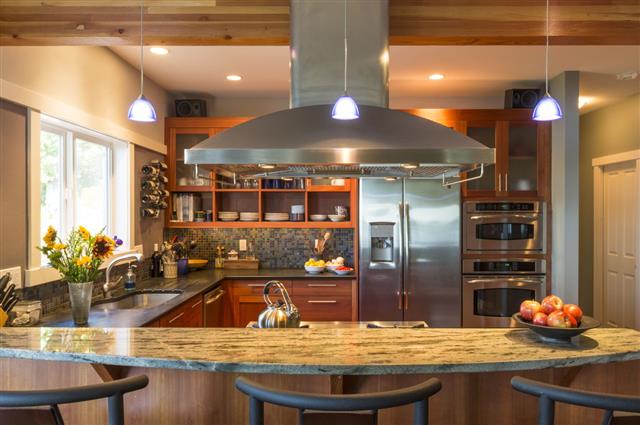
Planning to install a travertine countertop in your future kitchen or bathroom? If yes, then you should have a look at the pros and cons mentioned here.
A large number of homeowners are opting for the less expensive but sophisticated looking travertine for their kitchens, bathrooms, floors and walls. Travertine has been used in many beautiful structures around the world, be it the Coliseum around 2,000 years ago, or the more recent buildings by contemporary architects. It is a type of limestone that is formed under extreme heat and pressure, very porous, and almost looks like marble. In fact, it is sometimes called the onyx marble, and is imported into America from Italy, Mexico, Turkey, and the Middle East.
Travertine is available in many earthy colors, as it is a natural stone. You will find many beautiful shades of walnut, gold, cream, coral red, beige and ivory. These colors are formed due to the mix of iron and other impurities found in the earth. They have natural veining and holes, which make them all the more appealing. They look gorgeous and add an aesthetically pleasing touch to one’s home decor. Therefore, they are favored as flooring tiles, wall coverings, pavings and countertops. Countertops are available in polished, matte, brushed or tumbled finishes. The type of finish determines the shine of the surface.
The Pros
- As mentioned earlier, travertine countertops look beautiful and delicate, and adds a sense of elegance to the home. It looks luxurious and works wonders if you are looking for an antique look. The veining and imperfections only make people to want it more.
- Travertine is very good at reflecting light, which makes the kitchen a brighter place to work in.
- Travertine kitchen and bathroom countertops are very durable and last longer than most other materials. They can also be used for exterior and interior decorations. Since they also absorb water and moisture, installing them in bathrooms can be an excellent option.
- They are much easier to cut and shape as compared to porcelain tiles, therefore, making it very easy to fill spaces that are small or have odd dimensions. In fact, if you need to replace a tile, you can find one or two travertine tiles similar to the existing tile.
- Travertine is suitable for backsplashes, fireplace panels, showers and sinks. They are available in different shapes, sizes and designs, making them even more desirable. You can buy travertine as tiles or even slabs. There is also a choice between tiny mosaic tiles and 36-inch travertine tiles. They also weigh less than marble.
- Travertine will be the perfect choice if you want a good visual effect, and still need to keep the budget down. It is less expensive than granite and some other marble types. They are available for anywhere between $5 to $30 per square foot, depending upon the grade.
- Finally, if you are looking for an eco-friendly option to decorate your home, then travertine would be the best option for you, since it is an environment-friendly natural product.
The Cons
- The major drawback of having a travertine countertop is that it is highly reactive and can easily react to acids. Even a slight spillage of some orange or lime juice can stain it. It is not a good idea to install these countertops if you do heavy cooking in your kitchen. You may end up etching the surface if any liquid is not wiped off immediately.
- Travertine slabs need to be filled and sealed properly during installation. Once your countertop is installed, it will need a resealing every 2 to 3 years. You also have to disinfect it regularly, as there may be growth of bacteria due to the absorption of liquid.
- Travertine is quite soft and easily prone to scratches. One has to be really careful not to use any abrasive cleaning products or hard objects directly on the surface. Also, the more polished the surface, the more scratches are visible. Besides, it is not easy to repair any damage or breakage on these countertops.
- It cannot be kept in the path of direct or intense heat. These countertops need to be protected with the use of either cooling racks or rivets.
Now that you are aware of the advantages and disadvantages of these countertops, you can make the right choice according to your needs and usage. For these countertops, you need to use cleaning products that are designed specifically for natural stone. You should make use of coasters while keeping any beverage cup or glass on your countertop, and in case of any contact with acidic material like vinegar, juices, wine, etc., wipe the surface with a soft wet cloth in order to clean it.












